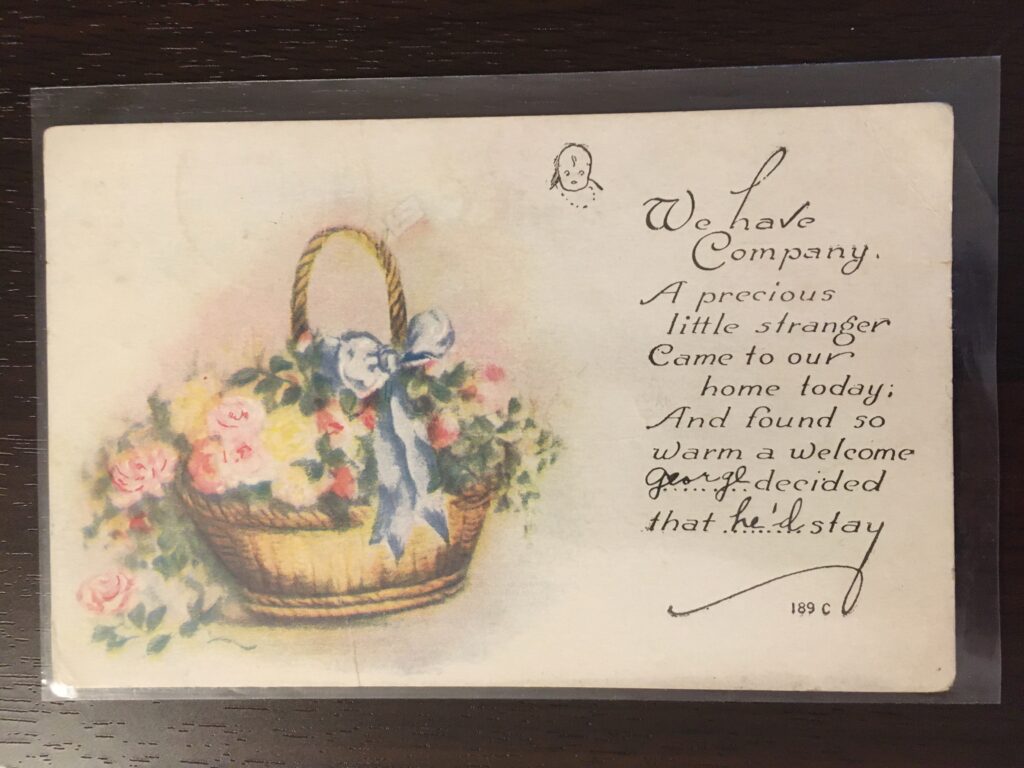It’s a bouncing baby . . . blog!
Welcome to a new blog organized around one of my research interests: early 20th century postcards, particularly those exchanged among people in the United States.

I credit (blame) a coworker for my getting hooked on these. Thus far my research suggests most (not all) scholarship on postcards has focused on the images and makers. Many people collect postcards for these–gathering cards related to particular places, manufacturers, themes.
I, on the other hand, am as or more interested in the reverse sides of postcards. A little over a year ago, I started collecting postcards that were directed to the same individual or family. Some discussions of postcards diss the inscriptions, lumping them into a few overarching categories of “wish you were here” from travelers and local minutia such as butcher shop or fertilizer orders. (I admit to owning a postcard where a salesman/shop alerts a person that their fertilizer order has arrived.)
But there’s a lot more to how people used postcards in the early 1900s. I’m still early enough in my research that I’m asking more questions than I answer. What questions am I asking? Here are some examples:
- How did people use postcards?
- What kinds of communications did they entrust to this potentially public medium?
- What purposes did postcards serve? For example, when one member of a family collected postcards, other family members sometimes routed communications through them so as to send messages and give the collector a card at the same time.
- What can postcards tell us about their senders and/or recipients?
Postcards are unfortunately a highly separable medium–since they’re also highly collectible, this means that countless thousands of postcards with inscriptions are scattered across different collections. I’ve been collecting postcards with an eye to accumulating batches sent to the same individual or family — and in some cases, I’ve scored batches that have large numbers not only directed to one person but also from one person.
I’m inviting you to accompany me on the journey as I work through the cards I’ve acquired and start piecing together my findings.
Here’s how this blog will work:
- I’ll post two times a week (probably Mondays & Thursdays)
- Posts will focus on a single postcard, back and front — I’ll provide photos, but not high-quality scans (at least not yet) — these are my photos and all postcards I share are in my possession
- I’ll provide my transcriptions and some of my initial thoughts and analysis.
- The first couple of posts will feature a few selections from my collection–but at the end of the month, I will instead present images and info about a particular postcard album. Starting with the first of the year, we’ll go through the album card by card. This is a very special album, perhaps one of the best deals I made when I picked it up half-on a whim. It has 138 cards almost all sent to the same individual–and over half sent by one person (the giver of the album to hold the cards).
So for today’s card — the front is above. A nicely drawn image clearly intended as a birth announcement (hence my choice for today!). The manufacturer carefully left two blanks, one for the baby’s name and the second for the pronoun.
![Mr Julian De Pew Peru Yau New York; Postmarked Holcomb N.Y., 10am 23 Feb. 1921. Some improvement, critical, two special nurses, some hopes now. Baby is fine and has dark hair and eyes. Name George D. Lumison[?] Weight: 7lbs 9ozs Date 3:30 A.M. Feb. 22. James & Emma.](https://aleahenle.com/wp-content/uploads/2020/11/IMG_3698-1024x768.jpeg)
Here’s the reverse of the birth announcement. James and Emma, presumably the parents, are sharing certain classic pieces of information: weight and time and date of birth. Interestingly, these are not the first items provided–rather the recipient is advised that someone is still critical but there has been improvement, two special nurses, and some hope. The general implication is that the mother had a hard labor–but that’s not guaranteed. There could be other circumstances, such as a family member also ill at the same time. Nevertheless, the line that the baby is fine without mention of the mother suggests she’s the one in critical condition.
Alas, the odds of piecing together the larger context for this are small. If you note the pencil markings at the top–“#55 $1.00”– they indicate this was sold individually at some point. I have some batches of postcards sent to the same individual that I picked up by laboriously going through dealers’ loose stocks, but I quickly switched to purchasing old albums instead. Most of my albums are the kind I wanted to get, but it took a learning curve to figure out how to identify them (and I still sometimes get it wrong), so I also wound up with one or two albums that are collections put together subsequently. These aren’t always random cards–I have one that seems to contain at least three separate smaller batches. The long and the short of it, though, is that for the foreseeable future this card is all we know about the parents and child. I could try to locate them in the census since I have names, a date, and a location–but at this point in time that’s not something I plan to do for this card. I have so many other people to research first.
At any rate, welcome. I hope you enjoy working through the cards with me.
“It’s a bouncing baby . . . blog,” copyright 2021, A.R. Henle.